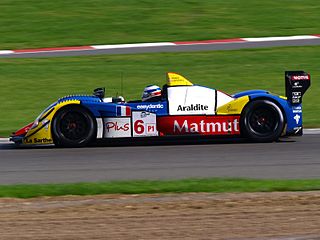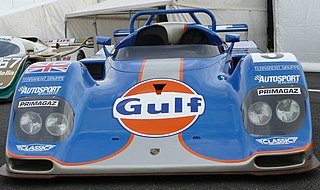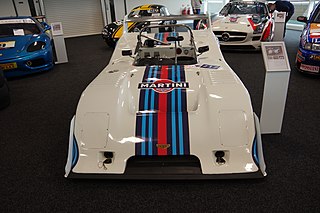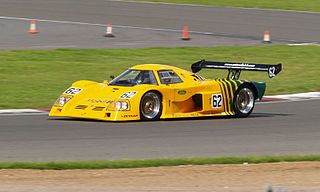
The 1996 24 Hours of Le Mans was the 64th Grand Prix of Endurance, and took place on 15 and 16 June 1996. It was won by a Tom Walkinshaw-Porsche prototype run by Joest Racing with drivers Davy Jones, Manuel Reuter and Le Mans rookie Alexander Wurz completing 354 laps. While not being the fastest car on track, it hit the front in the first hour and aside from several pit-stop overlaps, was never headed as other teams hit mechanical troubles during the race. This was Reuter's second Le Mans victory, and the first for Jones and Wurz, who, at 22 years old, became the youngest ever Le Mans overall winner.

Courage Compétition was a racing team and chassis constructor company now owned by Oreca, based in Le Mans, France, near the Circuit de la Sarthe. It was founded by Yves Courage, a French race driver who ran hillclimbs before founding the company. Following the purchase of Courage by Oreca in 2007, Yves Courage has refounded the company as Courage Technology in 2010, attempting to develop electric racing cars.

The Kremer K8 Spyder, along with its predecessor, the K7 (1992–1993), were open-cockpit prototypes built by Kremer Racing for use in multiple sportscar series, such as the IMSA GT Championship, Interserie, and International Sports Racing Series. The cars shared many components from the retired Porsche 962 and would eventually go on to win the 24 Hours of Daytona and several championships.

The Lancia LC2 was a series of racing cars built by Italian automobile manufacturer Lancia and powered by engines built by their sister company Ferrari. They were part of Lancia's official factory-backed effort in the World Sportscar Championship from 1983 to 1986, although they continued to be used by privateer teams until 1991. They were also the company's first car meeting the FIA's new Group C regulations for sports prototypes.
Richard Lloyd Racing (RLR), originally named GTi Engineering, was a British auto racing team created in 1977 by driver Richard Lloyd. Originally named for the Volkswagen Golf GTIs that Lloyd raced in the British Saloon Car Championship (BSCC), they went on to become a successful Porsche privateer in the World Sportscar Championship (WSC). Richard Lloyd Racing eventually folded at the end of the 1990 season due to the increased cost of the World Championship.
Dauer Sportwagen GmbH was a German automotive company founded by former racing driver Jochen Dauer in Nuremberg. Initially founded as Jochen Dauer Racing in 1987, the racing team had several years of participation in the German Supercup and European Interserie championships, as well as occasional runs in the World Sports-Prototype Championship and Camel GT Championships with the Porsche 962. Following the demise of sports prototype racing in the early 1990s, Dauer Racing GmbH was created to begin limited production of road cars, including a road-legal version of the 962, known as the Dauer 962 Le Mans, which later went on to win the 1994 24 Hours of Le Mans. Once changing to Dauer Sportwagen, the company sold a continuation of the Bugatti EB110. The company went bankrupt in 2008 and parts for the EB110 were transferred to Toscana-Motors GmbH.

Robin Donovan is a British former racing driver. He is best known for competing in 14 editions of the Le Mans 24 hours race; his best result there being 6th overall, 3rd in class (LMP1) and 1st privateer home driving with 5 x Le Mans winner Derek Bell MBE and Daytona 24 hours winner Jurgen Lassig in 1994 with the Gulf Racing entered and sponsored Kremer Porsche K8.

The Chevron B31 was a sports prototype racing car built by Chevron Cars Ltd in 1975, and initially used in the European 2-Litre Championship. The car was an evolution of the Chevron B26, and was initially fitted with a 2-litre Hart 420R straight-four engine producing 290 hp. However, various other engines were used; the car also ran with engines such as the 3-litre Cosworth DFV V8, the 2-litre Cosworth FVD/Cosworth BDG straight-four engines, and the 2-litre BMW M12 straight-four, amongst others.

The Ford C100 is a sports racing car, initially built and run as a Group 6 car, but later as a Group C car. The C100 was built by Ford in 1981, and initially featured a 4-litre Cosworth DFL V8 engine, which was replaced by a 3.3-litre version of the same engine in 1983, after the car had passed to private hands. Five cars are known to have been built. Although the cars were often very quick in qualifying, reliability problems plagued them, and restricted their successes to two Deutsche Rennsport Meisterschaft victories in 1982, and a single Thundersports victory in 1983.
The Cougar C01, and its derivative, the Cougar C01B, were Group C sports car prototype race cars, designed, developed, and built by French constructor Cougar in 1984, and was used in sports car racing from 1982 to 1984. Its best result in the World Sportscar Championship sports car racing series was a tenth-place finish 1983 1000 km of Mugello, being driven by Yves Courage, Aldo Bertuzzi, and Gianni Giudici.
The Lechner Spyder SC91 was a sports prototype racing car, originally built by Reynard Motorsport for Walter Lechner and his Walter Lechner Racing School Interserie team in 1991. The car was rebuilt as the Reynard Spyder in 1993, and became known as the Reynard Horag in 1997. Throughout its career, it used a Formula 1-derived 3.5-litre Judd V10 engine. One car was built, and it proved successful; taking the Interserie Division I title in 1997 and 1998, in addition to being the strongest non-Porsche 962 in 1991, and the strongest non-Kremer CK7 Spyder in 1993.

Willibert "Willi" Kauhsen is a German former racing driver and racing team owner from Eschweiler in Aachen, Germany.
Anthony Gordon Dean was a British racing driver from England who competed in sports car racing, touring car racing, the Can-Am series and various single seat formulae, including non-championship Formula One, in the 1960s, 1970s, and 1980s. He is known for winning a round of the Can-Am championship in 1970 as a privateer entrant.
Gebhardt Motorsport is a German motor racing team and constructor founded by brothers Günther and Fritz Gebhardt. Originally the team was formed to further the open wheel racing career of Günther Gebhardt as he progressed through Formula Super Vee and Formula 3 racing a succession of March and Ralt open wheelers. Gebhardt reached Formula 2 in 1982 racing a March 812 BMW but went no further before shifting to sportscar endurance racing.

The Courage C30, also known as the Courage C30LM, was a Group C2 sports prototype, designed, developed and built by French manufacturer Courage in 1993. It famously contested in the 1993 24 Hours of Le Mans, with drivers Derek Bell and Pierre Yver finishing in 10th and 11th place, respectively.

The Courage C36 was a Le Mans Prototype, designed, developed, and built by Courage Compétition team, to compete in sports car racing from 1996 to 1998. It is powered by a 3.0 L (180 cu in) 700 hp (520 kW) Porsche flat-six engine. Its best result was a 3rd-place finish at the 1997 FIA Sportscar Championship race at Zolder.
The Cougar C20 was a Group C sports car prototype used in sports car racing from 1987 to 1990.
The Cougar C22 was a Group C sports car prototype used in the World Sports-Prototype Championship sports car racing series, from 1988 to 1989.

The Cougar C26S was a Group C sports car prototype built by Courage Compétition. It was used in the World Sports-Prototype Championship sports car racing series in 1991. Power came from a 3.0-liter Porsche 6-cylinder turbocharged engine. It achieved one podium finish; with its best results being a 2nd-place finish at the 1991 Most Interserie race, being driven by Frenchman Lionel Robert.
The Cougar C12 was a Group C sports car prototype race car, designed, developed and built by French constructor Cougar in 1985, and used in sports car racing from 1985 to 1988. Its best result was an 18th-place finish at the 1986 24 Hours of Le Mans, being driven by Yves Courage, Alain de Cadenet, and Pierre-Henri Raphanel.











